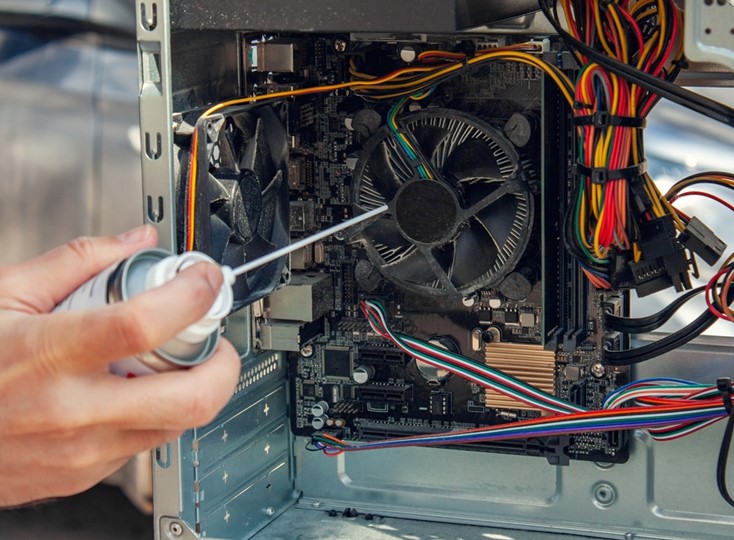- Like
- SHARE
- Digg
- Del
- Tumblr
- VKontakte
- Flattr
- Buffer
- Love This
- Save
- Odnoklassniki
- Meneame
- Blogger
- Amazon
- Yahoo Mail
- Gmail
- AOL
- Newsvine
- HackerNews
- Evernote
- MySpace
- Mail.ru
- Viadeo
- Line
- Comments
- Yummly
- SMS
- Viber
- Telegram
- JOIN
- Skype
- Facebook Messenger
- Kakao
- LiveJournal
- Yammer
- Edgar
- Fintel
- Mix
- Instapaper
- Copy Link
Whether your computer is a recent purchase or a long-standing fixture in your home, you might have noticed it has become less efficient. This decrease in performance is primarily due to dust accumulation.
The PC fans inside your machine are designed to circulate air to regulate temperature, but, unfortunately, they also attract dust particles. Dust buildup can impact your computer’s functionality if not addressed through regular cleaning and maintenance.
Knowing how dust can affect your PC is crucial for determining how frequently you need to clean it, identifying the most effective cleaning tools, and recognizing which components require the most attention during the cleaning process.
How Does Dust Impact Your Computer’s Performance?
Dust is a common problem that can impair the functioning of all types of computers, whether a high-end gaming desktop or a laptop. Here’s how the buildup of dust can negatively impact your computer’s performance:
Acts as an Insulator
Dust gathering inside your computer creates an insulating layer that traps heat, acting like a blanket. This dust layer can interfere with vital internal parts like the CPU, GPU, and motherboard by insulating them and keeping heat from escaping the case.
The result is less effective heat dissipation, causing temperatures to rise within the system. Prolonged exposure to this excess heat can harm sensitive components, diminishing their efficiency and accelerating wear and tear.
Prevents Fans from Dissipating Heat
When your computer is turned on and its hardware is running, each component inside generates heat at varying rates. Major heat-producing elements, such as the CPU and GPU, typically have their own fans.
Your PC case also features its own fans to provide airflow. While case fan sizes vary depending on the build, they all serve the same essential functions: pulling in cooler air from the outside and expelling hot air from the case, helping keep your hardware at a manageable temperature.
Dust also compromises your computer’s performance by obstructing the fans that cool the system. When fans or air vents are choked with dust, they can’t cool the system as effectively.
Dust-covered CPU and GPU fans lead to increased temperatures, and a dusty case means cool air isn’t drawn in, nor is hot air expelled properly. This situation causes a decline in your hardware’s efficiency, slowing down your computer.
In severe cases, the buildup can cause your computer to overheat, triggering a thermal shutdown to protect it from heat damage by turning it off suddenly.
How to Clean Your Computer

The best solution to ensure dust does not harm your computer is to remove it from your machine regularly. Follow these steps to clean your desktop computer and keep it as dust-free as possible:
- Power down and unplug: Turn off your computer and unplug the power cable from the power supply unit (PSU). This step ensures your safety and prevents electrical damage during cleaning.
- Open the case: Modern desktop PC cases are secured with two to four screws at the back holding the side panels in place. To access the inside, unscrew the screws on the side where you intend to open the panel. Typically, the motherboard is mounted on the right side, so you’ll usually need to open and remove the panel on the left. Be gentle with both the screws and panels as you work.
- Use compressed air: Compressed air canisters, or canned air, do not actually contain breathable air. They are instead filled with compressed gases designed to blow dust away and quickly dissipate. Before proceeding, ensure you use a brand of compressed air that is safe for electronics.With the case open, aim the nozzle at dust-covered parts, ensuring the particles are blown outside the case. Always use short bursts. Pressing down for too long risks expelling liquids. Components to look for include the CPU fan, heat sink, GPU fans, horizontal surfaces inside the case, and all case fans and exhaust ports.
- Remove visible dust: While compressed air can remove the bulk of dust from a particularly dusty machine, you may still need to manually remove dust from thick or old layers. This step will require you to touch your PC components. Wear an anti-static wristband before starting so you don’t damage them.Use an electronics-safe soft brush or microfiber cloth and rub all remaining dust away from any surface you can find inside. Be careful when handling soft or fragile components, such as fan blades or thin cables. If using a microfiber cloth, be mindful of small components and circuitry on which your cloth may snag.
- Spend extra time on fans: Due to their curved shape, fan blades tend to accumulate and retain the most dust inside a PC case. Don’t hesitate to spend as long as necessary cleaning each fan thoroughly and removing dust from every exhaust port. The extra effort will help restore your PC’s cooling and airflow.
- Finish and close the case: Once finished, check every cable you touched during the cleaning process and ensure everything is plugged in. Then, close the case, fasten the screws, and plug in your power cable again. Try powering your machine on and check its performance. Look for signs of unusual or abnormal behavior, such as noisy or gritty fans. They may indicate your PC needs further cleaning.
Preventative Maintenance for Better PC Performance
Periodically cleaning your machine is part of any PC’s routine maintenance. To get the most out of your machine and ensure it performs as well as possible, follow these additional maintenance tips:
- Consider your usage rates. The more often you use your PC, the more frequently you should clean it. Inspect the insides of your computer and adapt your periodic cleaning accordingly. For example, a PC that sees daily use should be cleaned more often than a machine that is only occasionally used.
- Be mindful of the PC’s environment. PCs placed on the floor, in a dusty area, or in rooms frequently occupied by pets tend to attract more dust, grit, and animal hair. To limit these risks, consider moving your PC to a higher surface, a cleaner room, or a pet-free area.
- Optimize the internal airflow. The components inside your case can affect airflow and cooling efficiency. Consider tidying your cable management or using additional case fans to boost your PC’s airflow. An online PC builder can help you find extra fans compatible with your case.
Keep Your PC Operating Smoothly
Dust is more than a nuisance — it can ruin your computer’s performance if not removed promptly.
Establish a regular cleaning schedule appropriate for your machine, and use the right tools to keep the dust away.
These measures will help prolong your PC’s lifespan, prevent heat issues, and preserve your hardware’s performance.


